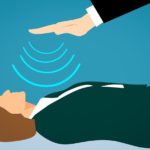As someone who enjoys writing, the concept of “words have power” is something I’m familiar with, but it was honestly the last thing on my mind when I uttered that forsaken phrase.
“Today seems quiet”.
Anywhere else, this statement would’ve merely accumulated a few nods of agreement and maybe resulted in some banter; in Robert Wood Johnson Rahway Hospital’s emergency room, however, it gathered groans, annoyed looks, and a few swears from the registered nurses I was shadowing.
“Stacy”, the nurse in charge of me, shook her head.
“If there’s one word we never use here in the ER, it’s the ‘Q-word’.”
All I could do was force a sheepish smile and apologize, hoping that I didn’t jinx the state of the ER(I did in fact, completely jinx the state of the ER).
After a few hours of idly sitting around, changing bedding, and disinfecting stretchers and equipment, Stacy called me over to help her with a patient- “Mary” – who had been complaining of a headache.
Because COVID-19 was still prevalent, hospitals were doing their best to make beds available as fast as possible. One of the ways they would do this was by sending mothers who performed uncomplicated vaginal births home within 24 hours of the delivery.
Mary had given birth Thursday of that week and was sent home early morning on Friday. That Friday night was when Mary told her husband that she felt as if her head was “splitting open”. Saturday morning, Mary was back in the hospital and was being kept for observation. Although her pain had subsided, she reported feeling dizzy at times and was unable to walk properly.
When Stacy and I first saw her, it was her concerned husband, “Greg” who called us over because something about her condition had changed. Doing his best to keep his emotions in check, Greg filled us in on what had changed with Mary while we began to observe her.
Facial drooping…. slurred speech. Pairing those two symptoms with her reports of intense headaches narrowed down the potential diagnosis to a stroke. Two more nurses joined us as we transported Mary to the MRI room to better understand her condition.
After putting her into the machine, I followed Stacy into a connected room where we would see the results of the scan appear on a computer. The technician pushed a few buttons, and we waited for the images to appear.
Having never been in such a scenario, I was both excited and anxious to see what the scan would show, despite knowing that I wouldn’t be able to make any sense of the images. The nurses, however, were calm- having conversations on the side about a colleague’s recent wedding. They asked me how EMT school was going, and how I was finding my time at the hospital, calming me down and making me feel more relaxed. I was in the middle of telling them about an exam I had coming up when the scans came in.
The nurses and technician took a few seconds to analyze the pictures, and a previously chatty room became dead silent.
Stacy turned around and grabbed me by the shoulders.
“Go back to the ER, find the head RN, and tell her to set up a code room, NOW!”
All I could do was nod and sprint back to the emergency room. I had no idea what the scan showed, or what exactly a code room was, but Stacy’s voice made the urgency of the situation evident.
When I got back to the ER, I followed the instructions I was given, and a flurry of nurses all gathered in one room and began setting up equipment. A few minutes later, Stacy and the other nurses from the MRI room arrived with a now unresponsive Mary on the stretcher.
After getting the stretcher into the room, the nurses began hooking Mary up to a machine to take her vitals, while other nurses gathered around to examine her.
My eyes widened as I saw her blood pressure and heart rate appear on the screen: 218/152 and 146 beats per minute respectively.
As the other nurses began setting up IV lines and other forms of interventions to stabilize Mary’s condition, Stacy handed me a bag valve mask and told me to help by performing ventilation, as Mary was not breathing effectively on her own.
I went over to her head, ensured that the mask had a proper seal, did a head-tilt-chin-lift to open up her airway, and began giving her breaths every five seconds, making sure I saw adequate chest rise with each pump. Being so focused on the task I was given, I was barely paying attention to all the other procedures the nurses were performing. I could only catch wind of some of the words being exchanged between them, which informed me that Mary was suffering from a hemorrhagic stroke- her brain was bleeding and therefore was not getting enough oxygen.
After a few minutes, or maybe more than just a few (I honestly completely lost track of time with all that was happening), paramedics arrived to transport Mary to RWJ’s New Brunswick Hospital, as her condition had become stable enough. One of them took over ventilating and all unnecessary personnel cleared out from the room to give them space to transport. I watched as Mary got wheeled away, and her husband- whom I had completely forgotten about- followed.
I can’t even tell you whether this was a happy ending or not because I have no clue what happened to Mary after that. In retrospect, what was most surprising to me was how quickly the atmosphere can change in a hospital. The nurses went from doing whatever they could for Mary, back to their previous personal conversations, as if they hadn’t just dealt with a life-or-death situation mere moments ago. For a newbie like me, this was incomprehensible- I had just gone from making sure that woman was getting oxygen in her lungs, to watching her get wheeled away without knowing what was going to happen to her.
Before Greg left the ER, I saw him turn around to thank one of the nurses for everything we had done. From when I had first seen him, to now, the difference was day and night. While on a superficial level, he was still holding everything together, one look at his eyes told you that he was frightened beyond belief- terrified for his wife’s life, praying that his newborn would grow up with a mother.
To this day, I still remember how bad I felt for that man and his family at that moment, and I was unable to believe that nurses could see what I had just seen and immediately return to going about their day. Unfortunately, that’s just the reality of emergency medicine. There aren’t always simple fixes, happy endings aren’t always the case, and sometimes, everything we do fails to be enough. Regardless, moving forward and keeping a clear mind is the only option, especially when another patient can fall into our hands within mere seconds.
I was deep in my thoughts, thinking about the events that had just transpired when Stacy approached me.
“And that’s exactly why we never use the ‘Q-word’.”



